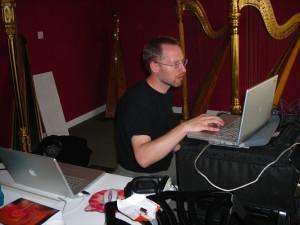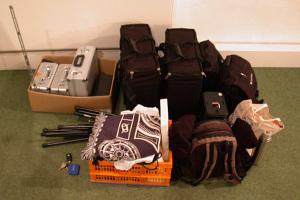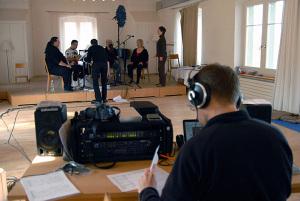Ralf Kleemann - Mobile Harp Recording
Ralf Kleemann is a harp player, composer, photographer, freelance software tester and glider pilot. He runs his own mobile sound recording business, specialising in recording harps and other acoustic instruments. As part two of our Harp People series, Clive Morley Harps has some questions for him…  CMH: A mobile harp recording service sounds very specialised. How did you come to get into it?
RK: First, I started to record myself with a very small setup—two condenser microphones (which I’m still using today) and a portable DAT machine, that was in the mid 1990′s. The basic idea was that I didn’t like the studio situation very much, in the sense that they cost you a lot of money without any guarantee for delivering good results, or allowing for an inspiring experience.
Later I decided to get more involved in sound engineering, which was not limited to harps at all. And surely enough, a microphone doesn’t discriminate—it just “feels” the vibrating air around it. Over the years I’ve done anything from large orchestras to Country bands. My favourite recording situations, however, are soloists with or without harps.
Specialising in harps was a function of being both a harpist and a sound engineer—with harps, there are some extra variables like tuning and other musical things (see below) that make them rather tricky to capture in a recording. Many harpists that come to me have already experienced some studios or recording situations in which the engineer followed his standard approach, but wasn’t aware of the specific issues that harps can display. Pointing a rock’n’roll microphone in the general direction of the harp is not enough sometimes. ;-)
CMH: We understand that you are prepared to travel long distances for a recording project?
RK: This simply means that I like to accommodate special project requirements—most people are tied to a certain region, or don’t want to record in unfamiliar environments. Mostly I record in natural acoustic spaces, such as churches or chapels, and mostly there happens to be one that the musicians feel very comfortable with. That way, they can remain in a familiar environment, which benefits the music. And nothing is as crucial as getting the initial recording right—what we don’t capture there, we will never be able to add later.
Luckily, recording technology has been getting smaller and smaller, so I can transport a very high quality setup in a medium-sized backpack. The whole setup is very scalable, so that I can capture anything from two to twelve channels simultaneously. I’ve also started doing video captures in HD quality, which is great for live events.
 CMH: Tell us about some of the projects you’ve recorded.
RK: I’m going to sum up three projects that may be representative:
Mareike Beyer, “Fasgadh’s Faeries”: I went to Applecross, Scotland with a minimalist stereo recording kit (two microphones, a two-channel Firewire interface, and a laptop computer). We recorded a solo album for celtic harp in an old church. Applecross is very secluded, and the place had a special meaning for the harpist, so the whole project became very unique.
Compagnie Skald, “Sangreal”: Here I recorded a harp with many additional voice & percussion tracks in a mountain chapel in Alsace, France. Once we had figured out how to heat the place, it was a lovely experience. The harp was very special, too, it has some resonating strings just like some classical Indian instruments have, and we spent a lot of time getting them in perfect tune. It was also the first time that I realised how to do multi-track recordings in an acoustic space like a chapel.
Eva Curth, “Visions Fugitives”: This was probably my reference for recording classical harp. We went to a small church and recorded multiple versions of the same pieces, to pick out the best ones afterwards. I have the utmost respect for classical harpists who sacrifice decades of their lives to be able to play the harp like that, and trying to record the music in the best and most accurate way possible seemed more than appropriate. I did an extensive test run before the recording sessions to find the best microphone positions, and luckily the room suited the music perfectly—not too much reverb, and a warm and detailed sound.
CMH: What are the particular challenges of recording the harp?
RK: After the previous question, I’d say that the non-technical aspects are as important as the musical ones. I want to have enough routine so that I don’t need to think about the gear too much. On the other hand, there’s no point in thinking about gear if so many other things need to be considered in front of the microphone. Sometimes having a thermos of hot tea and a bar of chocolate ready can be more important than moving a microphone back and forth by half an inch.
Harps are all very unique instruments with their own unique sound—and noises! They boom, they squeak, they have “funny” strings… so part of my task is to identify individual problems and solve them…
CMH: And how do you tackle them? RK: …for instance by trying out different microphone types and positions, by muffling a harp’s mechanism with small cardboard strips, or by stuffing a sound hole in the middle of the harp to prevent a boomy sound. Sound engineering is part of the musical process, so we might as well be creative. On a different note, it doesn’t become the musical performance if the engineer is nervous or hectic. As a consequence, I’ve adopted the use of checklists, much like in aviation, so that I absolutely cannot forget to pack the right cables and adaptors. This may apply to beginners and veterans alike.  CMH: Do you have any tips for harp players wanting to record themselves? RK: It may sound trivial, but the best hint I can give you is to tune your harp before you record. And to tune it again. If you are using one of those small solid-state recorders (Zoom etc.), please turn off automatic level control and record in an uncompressed format such as WAV with the highest available resolution (24 bit / 48 kHz or better). Place the recorder on a small tripod or stand, rather than on the ground, and you will get a much more natural sound. Try to combine the instrument with a nice acoustic environment, such as a nearby church or a concert hall in your area. You’ll be surprised. Once you get more serious about recording yourself, you will start using dedicated microphones. As for where to place them, I wrote a small article for the DPA Microphones Application Guide. The article is largely independent of the featured microphones.
CMH: And finally, would you like to tell us about any of your future plans?
RK: I’m working on various recording projects for the rest of this year, mainly solo harp or singer/songwriter projects. I’m also starting to work on my next harp album, which will probably be more of a multitrack project after I’ve published three solo albums.
I’m exceedingly happy with my choice of equipment, so there is little need to change it or talk much about it. For the gear-heads among the readers, I have a small list on my website.
As for the studio itself, it will remain as mobile as ever. Additionally, I’ve enabled some recording facilities in my house, located in a quiet forest area in northern Germany, including accommodation for the artist(s). That way there is a recording space for everything—not all projects require a big hall.
As a final word, I’m as happy to share my experience and knowledge as other people were to share theirs with me. Please don’t hesitate to drop me a line if you have questions, need buying advice, or want a second opinion for your recording project.
CMH: Ralf, thank you very much for sharing your expertise with us. As a result, we at Clive Morley Harps have been encouraged to have a go at recording ourselves – but we know where to go if we find we need some help!
Contact Ralf Kleemann:
http://studio.kleeworld.de
info@kleeworld.de |



